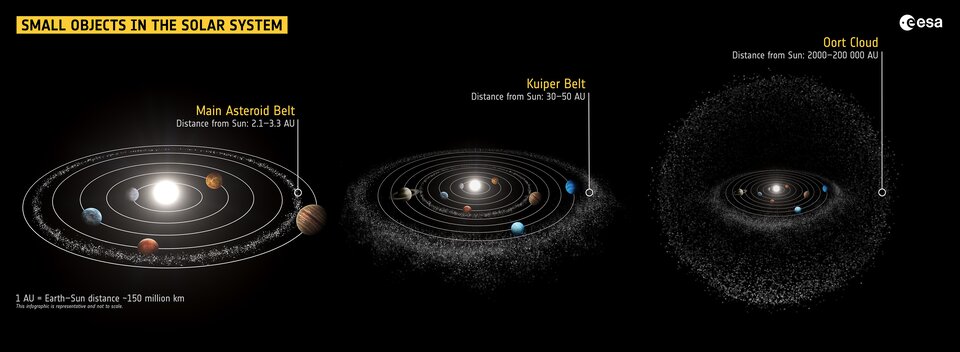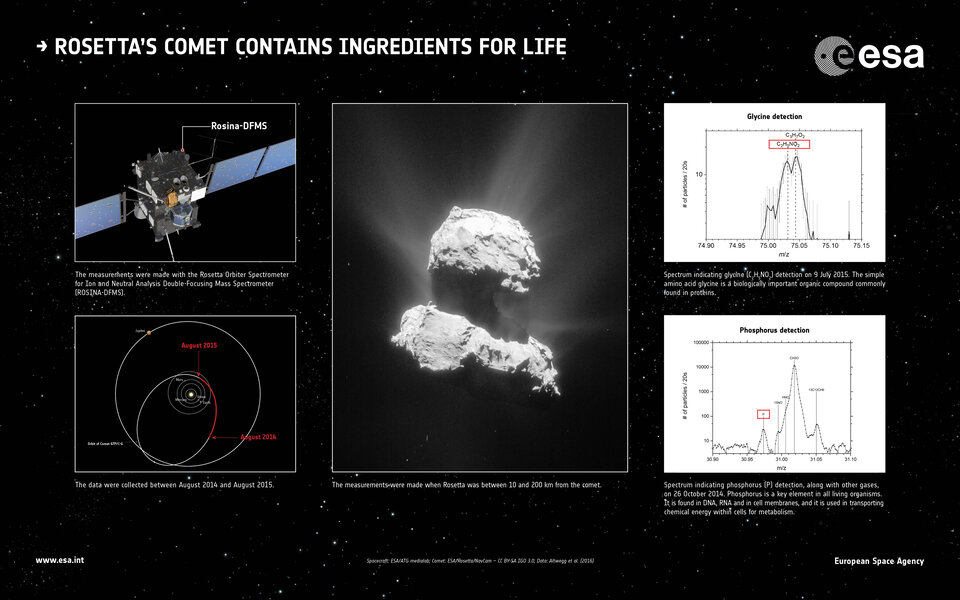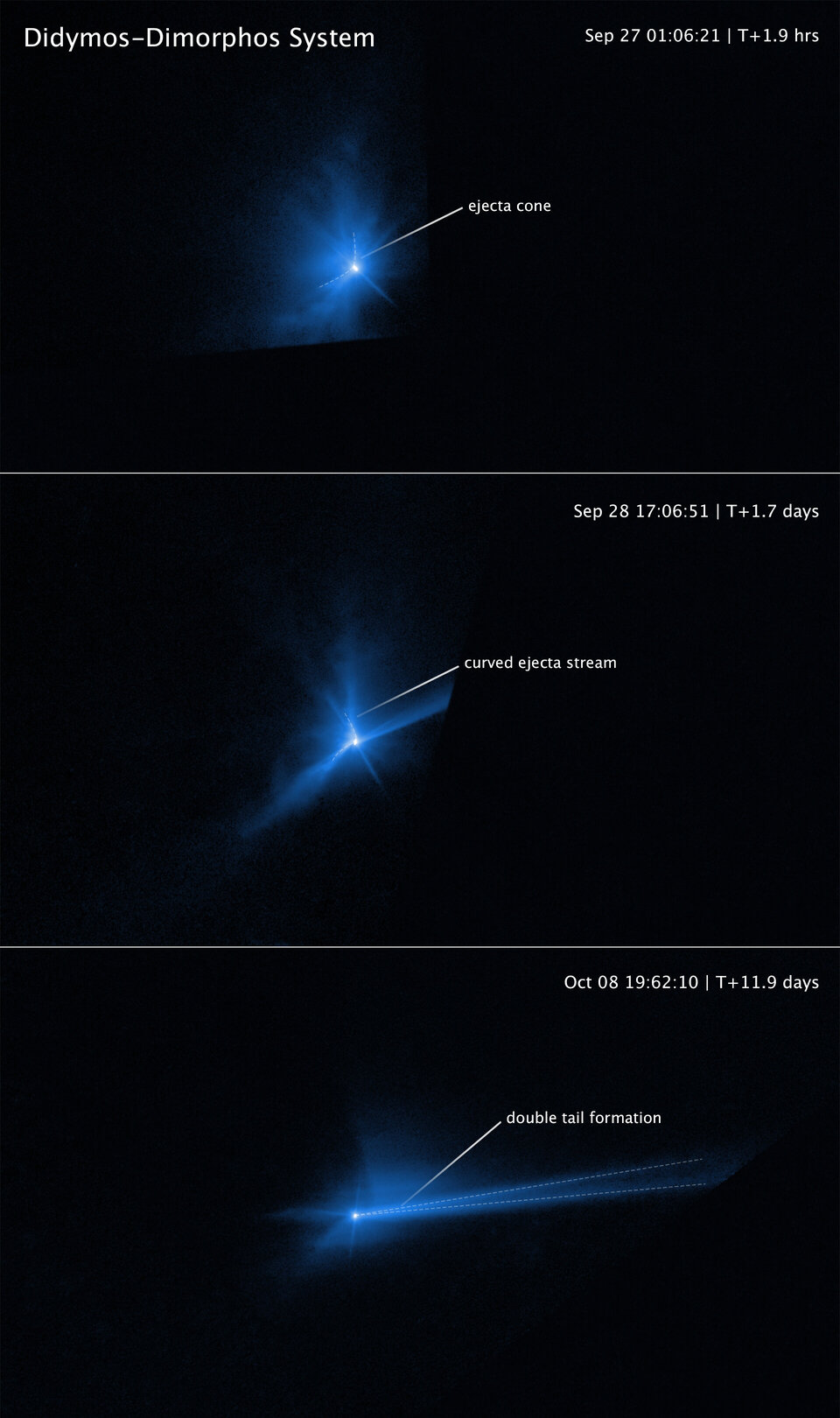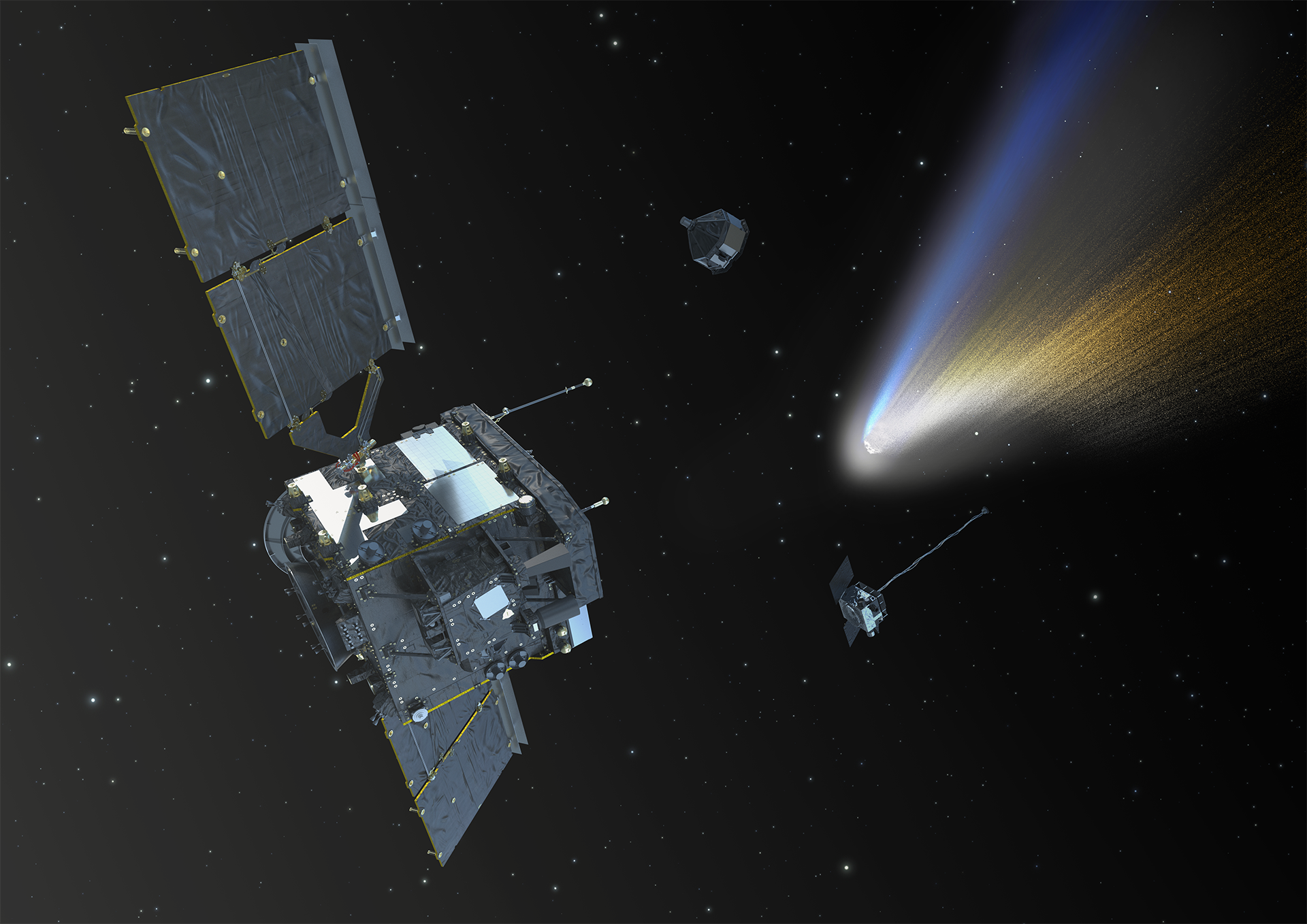Top five questions Comet Interceptor will help answer
Comet Interceptor will target a pristine comet entering the inner Solar System for the first time. Such objects are difficult to get close to because we can only detect them when they fly near the Sun, leaving little time to plan and launch a mission. That’s why Comet Interceptor will be parked in space, springing to life to intercept a comet when the time is right.
Comet Interceptor will address two core themes of ESA’s Cosmic Vision programme: How does the Solar System work? and What are the conditions for planet formation and the emergence of life?
So – what mysteries will Comet Interceptor solve?
1. What does a pristine comet or interstellar object look like up close?

Observing an object from a distance means we can only get rough information about its shape and structure. This is even worse for comets, because their surface is shrouded by a cloud of gases called a coma. The gases come from ices that vaporise when the comet gets closer to the Sun. The same process creates the spectacular tails that give comets their distinctive appearance.
Comet Interceptor is the first mission to take a close look at a pristine comet that has never or rarely entered the inner Solar System before. This could be a so-called long-period comet which comes from the outer reaches of the Sun’s realm, or maybe even an interstellar object that comes from outside the Solar System.
The mission will make a three-dimensional map of the comet’s solid nucleus and gassy surroundings. It will do so by splitting into three parts that take simultaneous measurements from all sides and from different distances as the comet passes by.
The measurements that Comet Interceptor makes will teach us about the target comet’s craters and depressions, how dusty or rocky its outer surface is, what compounds it carries and more.
2. How are pristine comets different from the comets we know?
Earlier comet science missions targeted short-period comets that orbit the Sun in less than 200 years. However, repeatedly flying past the Sun doesn’t leave a comet unscathed. The Sun’s radiation makes the comet heat up and become active, spewing out gases and dust, and erasing its original appearance and make-up.
By studying a more pristine type of comet, Comet Interceptor will teach us how comets are affected by their flight history. Crucially, by comparing the new data to measurements of short-period comets, we can see what’s different. These differences are important, because we base a lot of our understanding of the Solar System on the short-period comets we’ve studied in the past.
3. What was the early Solar System like?
Comets are thought to be the icy remnants left behind when the outer planets formed billions of years ago. As such, the structure and composition of comets tell us about what the Solar System was like when the planets were forming.
Rosetta’s up-close study of Comet 67P/Churyumov–Gerasimenko showed that comets grew slowly in the dusty early years of our Solar System, sometimes getting a bulgy shape when multiple baby comets slowly collided and merged. Comets remain light, porous and icy because unlike planets, their cores never compacted and heated up.
After forming, the much larger surrounding planetesimals and planets flung the comets outwards in a gravitational ‘pinball game’. Most comets currently live hundreds of billions of kilometres away in the Oort Cloud.

As such, comets are frozen time capsules, their makeup reflecting the early Solar System. Out in the Oort Cloud they have remained frozen and unchanged for billions of years. Occasionally, they are disturbed by the gravitational tug of a passing star, like shaking apples out of a tree, causing them to travel back towards the Sun. Only when they re-enter the inner Solar System do they heat up, get bombarded by particles in the solar wind, feel the magnetic field of the Sun, and potentially collide with planets, moons and asteroids.
Crucially, studying comets entering the inner Solar System is the only way for us to directly probe the Oort Cloud and, through it, the early Solar System. The existence of this ‘comet parking garage’ has been suspected and supported by theoretical models for decades, but it is too faint and distant for us to observe directly.
4. What is the role of comets in the appearance of life on Earth?
Comets are famous for their brilliant tails. These appear because comets are rich in volatiles: elements or compounds that change from a solid or liquid state into a vapour at relatively low temperatures. This includes water and other compounds containing the six most common elements of life on Earth: carbon, hydrogen, nitrogen, oxygen, sulphur and phosphorus. As such, comets crashing into Earth may have been important for the emergence of life.
One key question is the source of Earth’s water. We have a lot of it: 71% of our blue planet is covered by water. For a long time, it was believed that Earth formed as a hot dry planet, and that most water came from comets and asteroids crashing into it.
This role of comets was unexpectedly put into question when ESA’s Rosetta mission showed that the water on comet 67P/Churyumov–Gerasimenko has a different ‘flavour’ to the water on Earth. That is, the ratio of deuterium — an unusual form (isotope) of hydrogen with an additional neutron — to normal hydrogen in the water on the comet is very different to that on Earth.
Rosetta also detected organic material crucial for the development of life. This includes the amino acid glycine, which is commonly found in proteins, and phosphorus, a key component of DNA and cell membranes.

Comet Interceptor will determine which organic molecules and other ingredients relevant for life are present on its target object, including ratios of different element isotopes. For many compounds and isotope ratios, the mission will be the first to measure them in a long-period comet or interstellar object. This will assist in answering questions about how comets may have contributed to the surprisingly rapid emergence of life on Earth.
5. Should we be worried about a comet striking Earth?
The 2022 film Don’t Look Up tells the story of scientists detecting a large, long-period comet racing towards Earth, and our subsequent tragically comical failure to save ourselves from impending doom. This begs the question – should we be worried about a comet or interstellar object crashing into Earth?
Asteroids and comets pass by (and hit) Earth regularly, which is one of the reasons why ESA’s Planetary Defence Office set up the Near-Earth Objects Coordination Centre to compute asteroid and comet orbits and their probabilities of striking the Earth. Together with other space agencies, ESA is also investigating how we can deflect incoming objects.

In September 2022, NASA’s DART mission impacted Dimorphos, the moon of asteroid Didymos, changing its orbit in the world’s first technology demonstration of asteroid deflection. In 2024, ESA’s Hera mission will launch to investigate the post-impact state of the twin asteroids.
Luckily, the likelihood of a catastrophic comet impact in the foreseeable future is estimated to be vanishingly small. However, should a comet be on collision course with earth, the warning time would currently be too short in most cases. We usually can’t see them coming until some months in advance, and a deflection mission needs several years or even decades of lead time.
The time between detection of a hazardous object and its investigation or deflection by spacecraft can be reduced through ‘rapid response mission’. This is a mission that is built and launched beforehand and waiting in space until a relevant target appears. While not a planetary defence mission, Comet Interceptor is the first rapid response mission ever, validating this new way of doing a space mission.


